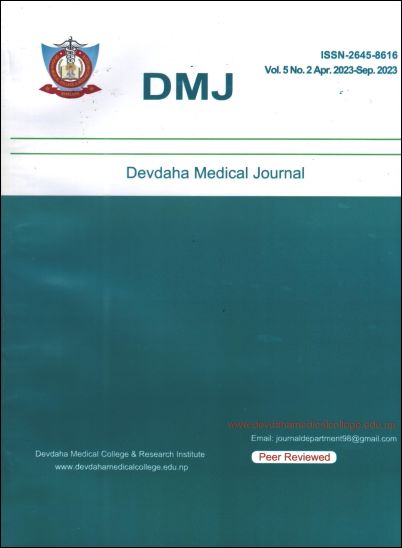Functional Outcome of Surgical Treatment for Displaced Clavicle Fracture
DOI:
https://doi.org/10.3126/dmj.v5i2.69792Keywords:
Mid shaft clavicle fracture, Open reduction and internal fixation with plate and screw (ORIF), Disability of arm shoulder and hand score (DASH), UnionAbstract
Introduction: Clavicle fracture is commonest of all shoulder girdle injuries and common among all fractures with the incidence more common in men than women. Fractures of the middle third clavicle are common of all clavicle fractures. Traditionally the fracture has been treated non operatively. The consensus of management is inclining towards the open reduction and internal fixation for displaced mid-clavicular fractures, as the conservative management gives poor results. In adults, non-operative treatment of a displaced middle-third clavicle fractures results poor. The aim of this interventional prospective study was to analyze the outcome of surgical management of displaced clavicle fracture managed with open reduction and plate and screws.
Method: This is a hospital-based, interventional, prospective study that includes all patients between 16 -65 years with displaced midshaft fracture of clavicle admitted at Universal College of Medical Sciences (UCMS), Bhairahawa treated by Open reduction and internal fixation with plate and screw from October 2017 to February 2019 follow up was done in 1.5 months, 3 months and 6 months, respectively.
Result: There were 30 patients, 23 were male and 7 were female. The mean age of patient was 31.9 years range 16-65 years. Road traffic accident was the most common cause of fractures. The mean time of union was 10.2 weeks. Left side was involved more than right clavicle. The mean duration of surgery was about 87.6 minutes and the mean duration of hospital stay was 12.1 days. The Robinsons type 2B1 fracture was most common. Most common complication was hardware prominence. There was one malunion following plate back out, mean disable arm shoulder and hand DASH score at 1.5 months, 3 months and 6 months were 43%, 24%, and 9% respectively.
Conclusion: Displaced mid-shaft clavicle can be effectively treated by open reduction and internal fixation with plate and screw (ORIF) as it improves the functional outcome, DASH score and promotes earlier union.




